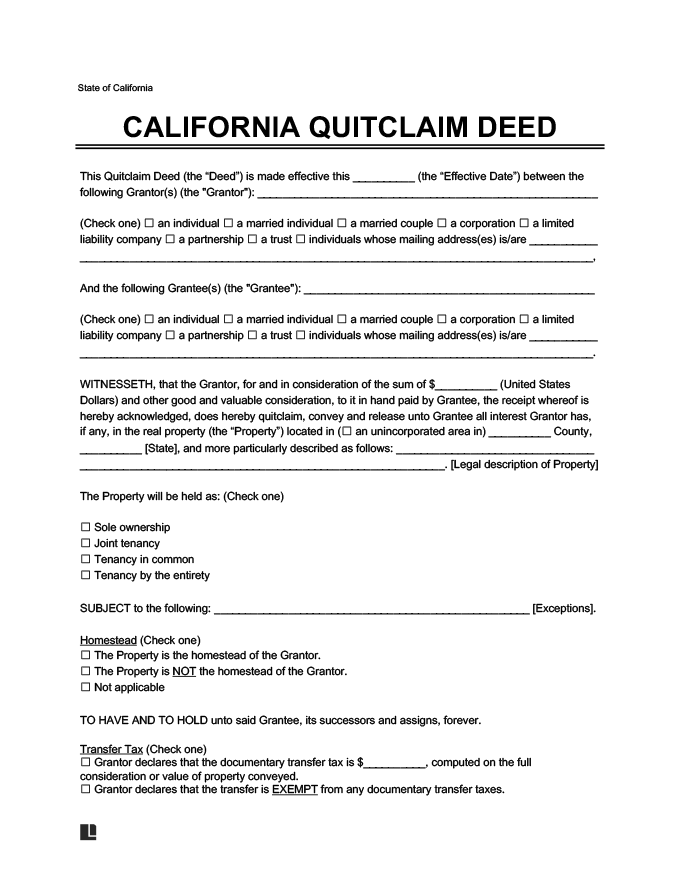Filing a quitclaim deed in California is essential for the proper transfer of property ownership. Whether you’re passing property to family, releasing ownership, or updating ownership details, following these steps is crucial.
- Step 1: Obtain the Deed
- Step 2: Visit the County Recorder or Clerk
- Step 3: Identify the Legal Description of the Property
- Step 4: Consider Legal Assistance
- Step 5: Complete the Quitclaim Form
- Step 6: Sign in Front of a Notary
- Step 7: File a Preliminary Change of Ownership Report (PCOR)
- Step 8: File the Forms
- Step 9: Provide the Deed to the Grantee
Step 1: Obtain the Deed
Before proceeding with the quitclaim deed filing process, it’s essential to have the original deed to the property. If you’re not the current owner, request a copy of the deed from the current owner. Ensure the document is in your possession before moving forward.
Step 2: Visit the County Recorder or Clerk
If you don’t have access to the deed, visit the County Recorder or Clerk’s office to obtain a copy. Expect to pay a fee for each page, which varies depending on the county. Typically, fees range from $1 to $12 for the first page and $1 to $3 for each additional page. Check with your county’s office for specific fee details.
Locate the appropriate County Recorder’s office by referring to this list.
Step 3: Identify the Legal Description of the Property
A legal description is crucial in real estate conveyance and legal disputes. A proper legal description, one that identifies and locates the property, is required for deeds to be valid (Cal. Civ. Code § 1092).
In California, legal descriptions are typically created using three distinct systems:
- Rectangular Survey System
- Metes and Bounds System
- Lot and Block System.
Each approach comes with its unique set of criteria, tailored to suit the particular location and characteristics of the property in question.
Step 4: Consider Legal Assistance
If you’re unsure about the quitclaim deed process or need legal advice, consider seeking assistance from a qualified attorney. They can provide guidance and ensure the deed is completed correctly. Use resources like the State Bar of California’s Lawyer Referral Service or www.lawhelpca.org to find legal assistance if needed.
Step 5: Complete the Quitclaim Form
Provide all required information, including the Assessor’s Parcel Number, document transfer tax, names of grantors and grantees, and the legal description of the property. Double-check for accuracy before proceeding.
Visit your County Recorder or Clerk’s office to obtain the necessary forms for filing a quitclaim deed.
Step 6: Sign in Front of a Notary
Once the form is completed, sign it in the presence of a notary public. Notaries can usually be found at courthouses, large banks, or the County Recorder or Clerk’s office. Ensure you bring sufficient personal identification, such as a valid driver’s license or passport, for verification purposes.
Step 7: File a Preliminary Change of Ownership Report (PCOR)
The Preliminary Change of Ownership Report (PCOR), Form BOE-502-A, is an essential document that facilitates the seamless transfer of property ownership and ensures accurate tax records. When a property changes hands, it’s imperative to submit the PCOR, signed by the grantee (buyer), along with the deed to the County Recorder’s Office.
Each county may have its own unique version of the PCOR, so it’s advisable to reach out to the Recorder’s office in the specific county where the property is located to obtain the appropriate form.
Step 8: File the Forms
Take both the completed quitclaim deed form and the PCOR to the County Recorder or Clerk’s office for filing. Expect to pay a recording fee, which varies by county. Recording fees typically range from $6 to $21 for the first page and $3 for each additional page.
You may also be required to cover the cost of the Documentary Transfer Tax, along with a $75 fee for the “Building Homes and Jobs Act.”
Step 9: Provide the Deed to the Grantee
Once the forms are filed, provide the recorded original deed to the grantee (buyer). Depending on the county, you may receive the recorded original immediately or via mail at a later date. Keep a copy of the deed for your records and store it securely in a home safe or safety deposit box.
